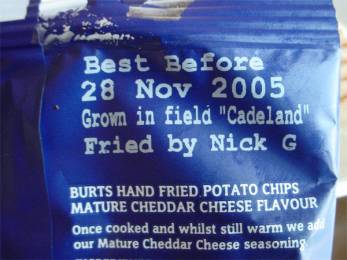
Food & drink
Single sex foods
If men and women are different (debatable, but in some ways true) then why are their foods generally the same? This is the argument behind a nascent trend in the US food industry that's been called everything from 'gender vending' to 'single sex selling'. Historically, there have been plenty of examples of foods that have been marketed exclusively to women (vitamin supplements for example) but the list is growing. Recent examples in the US include Harmony cereal and Nutrition for Women oatmeal. So what about men? So far the only 'men only' foods we can find (if you don't include beer) are Campbell's Chunky soup (now promoted to women in some countries). There's also the Kit-Kat chocolate bar in the UK, which prides itself in packaging that says 'Not for girls', but we suspect they don't really mean it.
Ref: Better Homes and Gardens (US) 'Top ten trends in food and cooking for 2005'. www.bhg.com
Mixed messages
Two recent surveys highlight the problem facing consumers and food manufacturers alike about what to say and whom to believe. The first survey, by the UK Food Commission, says that families (and in particular children) are being duped by increasingly sophisticated marketing techniques designed to fly under the radar of any future advertising bans. For example, Nestlé is giving away personalised books linked to its Milky Bar brand, while McDonalds is endorsing the sale of toy burgers and plastic French fries which form part of a play food set. However, as one critic of the report has said, such merchandising is hardly anything new. The second report, by Mintel, says that consumers are getting "fed up" and confused by the volume of messages delivered by government ministries and health charities, some of which are contradictory.
Ref: Weekly Telegraph (UK) issue no 719. www.telegraph.co.uk
Latest restaurant ideas
You can't eat atmosphere - but it can only be a matter of time before you can. A restaurant called Moto in Chicago (US) features edible menus made from soybean, potato starch and vegetable ink. Could this 'tasting menu' idea be taken further? What if you could tear out an ad from a magazine and literally taste what was being advertised? If this idea isn't quite flavour of the month, then how about a restaurant that lets diners decide what size portion they want and what they want to pay for it? The One World Cafˇ in Salt Lake City (US) does just this. New idea? Not quite. Customers in a steak restaurant in Arizona (US) used to enter via the kitchen and talk to the chef about what was on offer (similar to some Tavernas in Greece). The only thing on offer was steak so you decided what cut and size you wanted and how you wanted it cooked. There was also a restaurant in London many years ago where diners could pay whatever they thought the meal was worth. Not surprising the concept didn't last long because most customers left as little as possible.
Ref: Trendcentral (US) 8 March 2005. 'The art of dining'. www.trendcentral.com
30% of food is rubbish
According to a survey by a company called C-Tech, 35-40% of food produced in Britain is thrown away. This compares to 25% in the US and is the worst in the world. The volume of this waste is approximately 17 million tonnes valued at around GB £8billion -£16 billion a year. Separate research by the UK government puts the figure at 17 million tonnes worth GB £20 billion. The waste itself is generated by farmers, food processors, food retailers and households. As much as a third by weight of household rubbish is food waste. 25% of all food waste that is thrown away could be used for the production of energy according to the C-Tech report. In contrast, putting food waste into landfills cost about GB £ 175 million every year. As for the cause of the problem, it's twofold; people buy more than they can eat and retailers (especially supermarkets) reject perfectly edible food because it is the wrong shape, wrong colour or the wrong flavour.
Ref: The Guardian Weekly (UK) 22-28 April 2005. 'More than 30% of food is thrown away', J.Vidal. www.guardian.co.uk
How often do people cook?
Here's a little nugget from the UK Food Standards Agency - some research on how often people cook a proper meal. According to the Agency's Consumer Attitudes Survey 43% of people cook a meal from scratch every day while a further 27% cook a meal two to three times a week. 7% never cook and 21% never or very rarely cook for themselves. What's interesting about these figures, if they are to be believed, is that people in the UK are not as reliant on so-called junk food as the UK government and media would have us believe.
Ref: Various including MORI/The Times (UK). www.timesonline.co.uk
